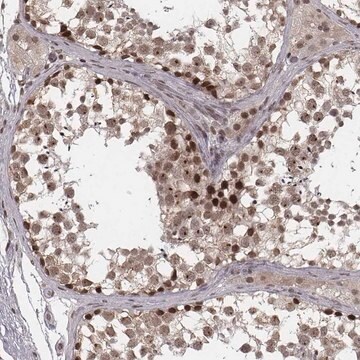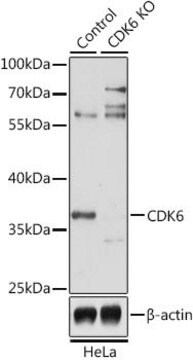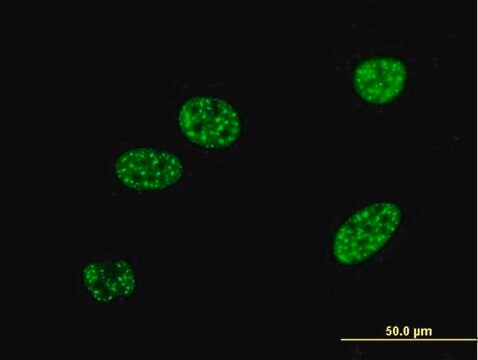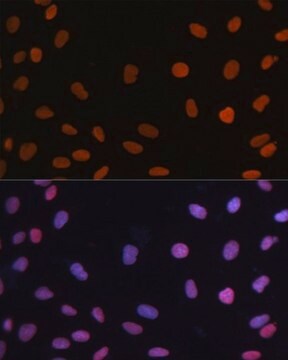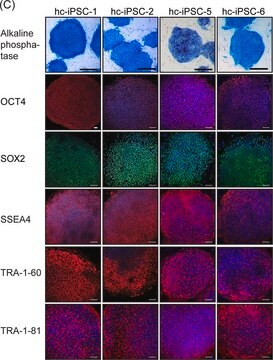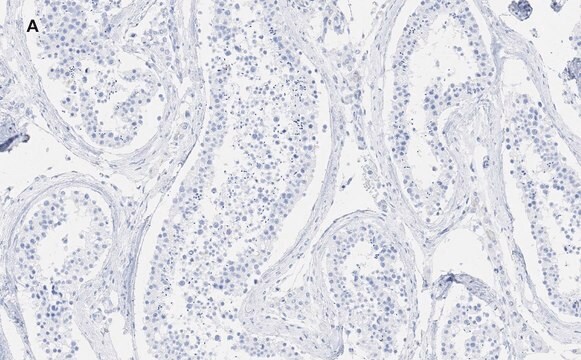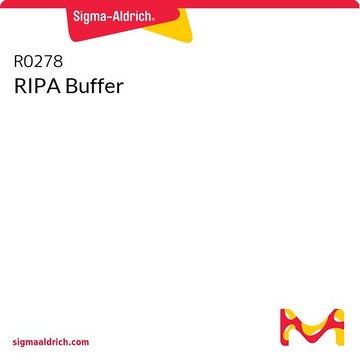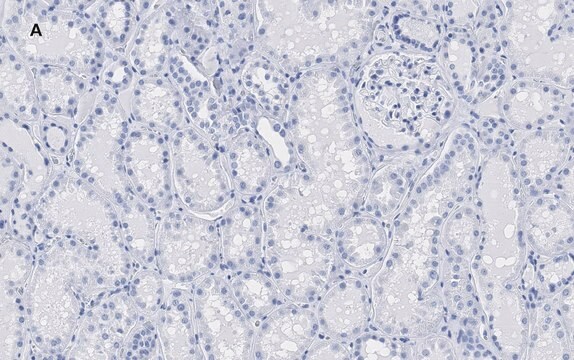추천 제품
생물학적 소스
mouse
Quality Level
결합
unconjugated
항체 형태
purified immunoglobulin
항체 생산 유형
primary antibodies
클론
2D10, monoclonal
양식
buffered aqueous solution
종 반응성
human
기술
immunofluorescence: suitable
indirect ELISA: suitable
western blot: 1-5 μg/mL
동형
IgG1κ
GenBank 수납 번호
UniProt 수납 번호
배송 상태
dry ice
저장 온도
−20°C
타겟 번역 후 변형
unmodified
유전자 정보
human ... HMGA2(8091)
일반 설명
This gene encodes a protein that belongs to the non-histone chromosomal high mobility group (HMG) protein family. HMG proteins function as architectural factors and are essential components of the enhancesome. This protein contains structural DNA-binding domains and may act as a transcriptional regulating factor. Identification of the deletion, amplification, and rearrangement of this gene that are associated with myxoid liposarcoma suggests a role in adipogenesis and mesenchymal differentiation. A gene knock out study of the mouse counterpart demonstrated that this gene is involved in diet-induced obesity. Alternate transcriptional splice variants, encoding different isoforms, have been characterized. (provided by RefSeq)
면역원
HMGA2 (NP_003474, 1 a.a. ~ 92 a.a) partial recombinant protein with GST tag. MW of the GST tag alone is 26 KDa.
Sequence
MSARGEGAGQPSTSAQGQPAAPAPQKRGRGRPRKQQQEPTGEPSPKRPRGRPKGSKNKSPSKAAQKKAEATGEKRPRGRPRKWPQQVVQKKP
Sequence
MSARGEGAGQPSTSAQGQPAAPAPQKRGRGRPRKQQQEPTGEPSPKRPRGRPKGSKNKSPSKAAQKKAEATGEKRPRGRPRKWPQQVVQKKP
물리적 형태
Solution in phosphate buffered saline, pH 7.4
법적 정보
GenBank is a registered trademark of United States Department of Health and Human Services
면책조항
Unless otherwise stated in our catalog or other company documentation accompanying the product(s), our products are intended for research use only and are not to be used for any other purpose, which includes but is not limited to, unauthorized commercial uses, in vitro diagnostic uses, ex vivo or in vivo therapeutic uses or any type of consumption or application to humans or animals.
적합한 제품을 찾을 수 없으신가요?
당사의 제품 선택기 도구.을(를) 시도해 보세요.
Storage Class Code
10 - Combustible liquids
Flash Point (°F)
Not applicable
Flash Point (°C)
Not applicable
개인 보호 장비
Eyeshields, Gloves, multi-purpose combination respirator cartridge (US)
가장 최신 버전 중 하나를 선택하세요:
시험 성적서(COA)
Lot/Batch Number
Bin Liu et al.
Human pathology, 45(8), 1752-1758 (2014-06-18)
High-mobility group AT-hook protein 2 (HMGA2) is an architectural transcription factor associated with malignancy, invasiveness, and poor prognosis in a variety of human neoplasms. This study investigated HMGA2 expression and prognostic value in human gliomas. We also correlated HMGA2 expression
Chung-Ta Lee et al.
Human pathology, 45(11), 2334-2340 (2014-09-24)
High-mobility group AT-hook 2 (HMGA2) regulates cell growth, differentiation, apoptosis, and neoplastic transformation. Previous studies have shown that malignant tumors expressing HMGA2, such as gastric, lung, and colorectal carcinomas, usually have a poor prognosis. HMGA2 expression and its clinical significance
Yuheng Tian et al.
Cell cycle (Georgetown, Tex.), 17(10), 1188-1198 (2018-06-09)
Long non-coding RNAs (lncRNAs) can actively participate in tumorigenesis in various cancers. However, the involvement of lncRNA long stress induced non-coding transcripts 5 (LSINCT5) in non-small cell lung cancer (NSCLC) remains largely unknown. Here we showed a novel lncRNA signature
Dequan Kong et al.
Medical oncology (Northwood, London, England), 31(8), 130-130 (2014-07-20)
High mobility group protein A2 (HMGA2) and octamer-binding transcription factor 4 (Oct4) are transcription factors that play major roles in the acquisition of cancer stemness phenotypes and tumorigenicity of malignant neoplasms. The aim of this study was to analyze the
Rika Fujii et al.
The Journal of steroid biochemistry and molecular biology, 144 Pt B, 513-522 (2014-09-03)
Aromatase inhibitors (AI) are commonly used to treat postmenopausal estrogen-receptor (ER)-positive breast carcinoma. However, resistance to AI is sometimes acquired, and the molecular mechanisms underlying such resistance are largely unclear. Recent studies suggest that AI treatment increases androgen activity during
자사의 과학자팀은 생명 과학, 재료 과학, 화학 합성, 크로마토그래피, 분석 및 기타 많은 영역을 포함한 모든 과학 분야에 경험이 있습니다..
고객지원팀으로 연락바랍니다.